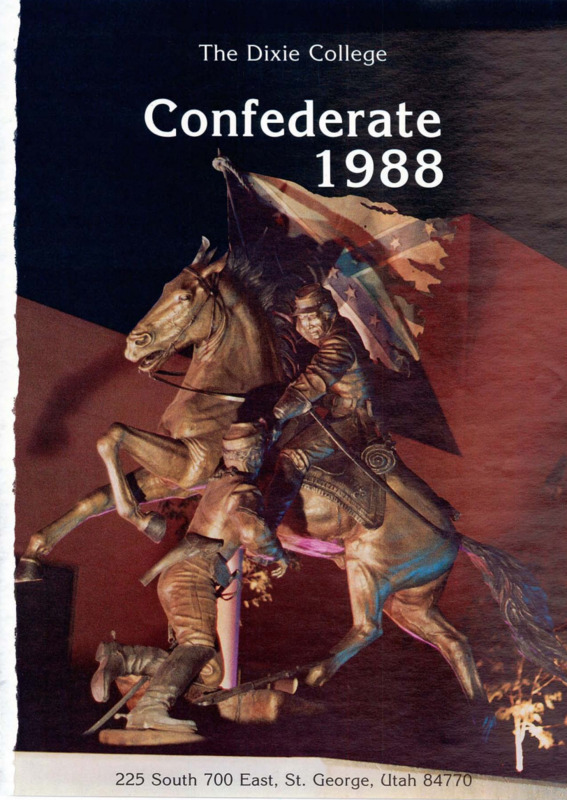The Rebels of Dixie State

In the 1980s, St. George locals commissioned a Utah artist to create a larger version of an earlier work depicting two Union soldiers. There was one request: change the soldiers to Confederates.
A statue on Dixie State College campus depicted a scene right out of American history: a Civil War soldier rode on horseback through a battlefield, reaching down to grab a comrade by the arm and lift him out of danger. The artist, Jerry Anderson of southern Utah, said his message was “one man helping another” and that the statue “represented every war in every country.”
For a growing proportion of the St. George community in 2012, though, three sticking points of the statue overshadowed this supposed message. The statue’s name was The Rebels, the boys depicted were not Union soldiers, and the rider brandished a large Confederate battle flag. Why, people asked, was this Confederate statue on the campus of Dixie State College in St. George, Utah?
The story began in 1982 when Anderson finished his latest work: a small statue titled Retreat. Based on the song “Two Little Boys,” it depicted two Union soldiers in a pose similar to The Rebels, one reaching down to rescue another. In 1983, a group of St. George residents commissioned Anderson to create a similar work at a larger scale, with one change requested: replace the Union soldiers with Confederates. The commissioners wanted to donate the statue to the city of St. George, and they told Anderson they wanted it to visually relate to Dixie College’s mascot: Rodney the Rebel. Formerly the Flyers, the mascot became Rodney the Rebel in the 1950s, during the era of Southern Dixiecrat revivals of Confederate imagery to promote segregation (see tour introduction “Confederate Imagery in the Intermountain West”). Anderson complied with the request.
After four years of work, Anderson completed the statue, and it was dedicated at the Dixie Center Plaza on March 14, 1987 as part of a Dixie “Secession” Fair held as a fundraiser by the Chamber of Commerce (see “The Dixie ‘Secessions’ of 1987 and 1988”). Then called Two Little Boys, the statue later came to be known by its current name, The Rebels.
The Rebels passed the next two decades seemingly quietly. When the city built a new convention center, it sold the old center’s property to the state of Utah, which added the land to Dixie State College.
In 2005, the Dixie mascot changed to the Red Storm, and later again to Brooks the Bison (the current mascot), but The Rebels kept its place on campus and its name.
In 2012, however, controversy thrust The Rebels into the statewide spotlight. Dixie State College was in the middle of a four-year process to transition into a university by 2013, and university status would require a new name for the institution. While some favored Dixie State University as an obvious choice, others requested a name that did not include “Dixie.” Newspaper editorials, students, and other community members criticized the name “Dixie” for its ties to the Confederate States of America, itself from the “Dixie” American South for which southern Utah had been nicknamed, and advocates cited The Rebels as evidence of a connection between the Dixie name and Confederate imagery. By late November 2012, community members staged anti-racism rallies around the statue, and in one demonstration a protester threw a sheet over the statue’s Confederate flag. (For more, see “The Confederate Connections at Dixie State University.”)
On December 6, 2012, Dixie State College moved the statue into storage as a precaution against damage or vandalism. Dixie State President Stephen Nadauld said, “The statue has become a lighting rod… We are nervous something might happen to the statue.”
Anderson criticized the decision and accused the college of being “wusses.” In an interview with local news, Anderson said the college “should have kept it up,” and he used racially charged language to make his point. “Let the black people, or whoever is fighting against it, try to disfigure it in some way, and put them in jail where they belong,” he said. “They don’t stand up for what we, in St. George, believe in.”
The Rebels stayed in storage for two years while the college became a university and investigated the statue’s ownership. Anderson’s clients originally donated the statue to the city of St. George, and while the state of Utah had purchased the land it sat on, the college was unsure if that included the statue.
Two years later, in 2015, a judge finally declared Dixie State University the legal owners of The Rebels. On January 13, Dixie State announced it would move the statue out of storage and return it to Anderson in exchange for him donating another work to display on campus. When asked about the statue’s departure from Dixie State campus, Anderson said, “You've got to make everybody happy, is what I've learned from it all.”
Anderson moved the statue to his personal gallery in Leeds, Utah, where he displayed it by the front door as recently as February 2020. By January 2021, Anderson gave The Rebels to an unidentified friend, where it most likely remains.
Images




